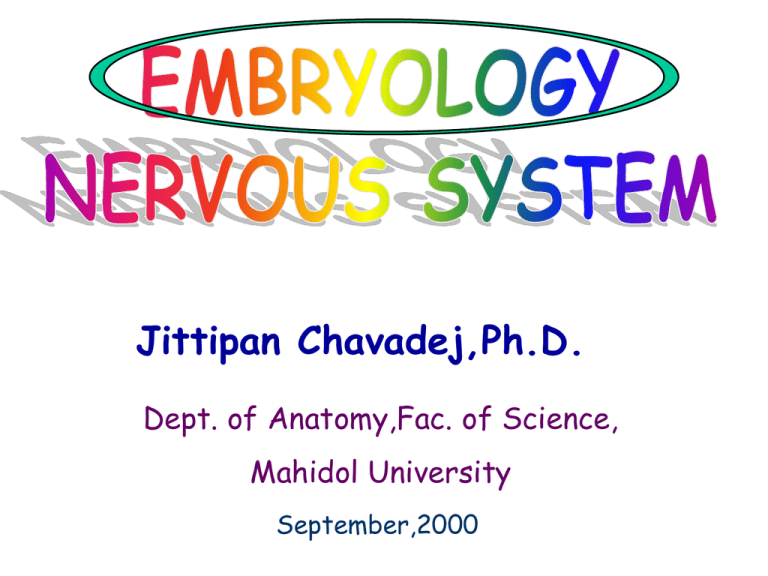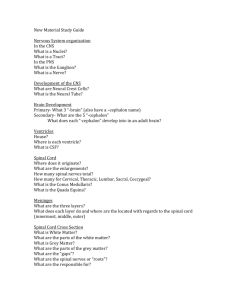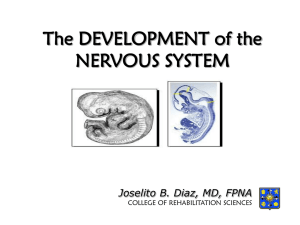Spinal cord - Mahidol University
advertisement

Jittipan Chavadej,Ph.D. Dept. of Anatomy,Fac. of Science, Mahidol University September,2000 Diagrams showing formation of the neural groove, neural tube and neural crest Neural tube-neural crest Neural tube-brain & spinal cord Neural crest-most components of PNS -non-neural component in the body and head. Fundamental processes in Nervous system formation •Induction-Proliferation •Migration-Differentiation •Pattern formation •Intercellular communication •Stabilization or Elimination •Development of integrated pattern Changes in Gross Structure of NS •Closure of neural tube 24th-day -cranial neuropore 26th-day -caudal neuropore •Cephalic end-primary brain vesicles -procencephalon -mesencephalon -rhombencephalon •Spinal cord 3-wk. Embryo : - C shape - cephalic flexure (mesencephalon) - cervical flexure (hind brain&spinal cord) 5-wk. Embryo : - procencephalon-Telen., Dien. -mesencephalon -rhombencephalon-Meten., Myelen. A-lateral view of the brain vesicles and part of spinal cord. B-diagram showing the cavities of the three brain vesicles and spinal cord Diencephalon - optic vesicles Mesencephalon - sharply bend by cephalic flexure Rhombencephalon - Pontine flexure thin roof Basic anatomy of the five-part human brain Histogenesis within Nervous System •2 major cell lineages - Neuronal progenitor cell neurons - Glial progenitor cell astrocyte, oligodrendrocyte, ependyma (neural tube) *Microglia-enter CNS from outside Cell lineages in the developing central nervous system Neuron-large cell body -long processe -axon-carry signals to targets -dendrites-receive input Neurons need to “ reach out and touch “ each other by forming synapses to survive. Development of nervous system components Formation of Zones 1. Ventricular zone-ependymal cells become epithelial lining of central canal 2. Mantle zone-neuroblast cells become gray matter of the CNS 3. Marginal zone-neuronal processes become white matter of the CNS Formation of zones & fundamental organization of the developing neural tube Note: -ependymal zone -mantle zone -marginal zone Fundamental Organization of Neural tube Dorsal portion/Alar plate/sensory <---Sulcus limitans Ventral portion/Basal plate/motor Roof plate - Floor plate A-development of regional specialization across the neural tube. B-formation of the spinal cord Spinal cord formation ** Basic plan of neural tube is preserved in spinal cord ** •Mantle zone = H-shape of gray matter with central canal •Marginal zone = White matter -->>myelinated nerve fibers Spinal cord - PNS Ventral aspect •Neuroblasts of basal plate ->> outgrowth of axons -->ventral nerve root Dorsal aspect •Thin processes of neuroblast of spinal ganglion-->dorsal nerve root Development of a peripheral nerve A-showing motor axon, growing fiber of nerve cell in DRG. B-showing ventral motor and dorsal sensory root joining to form the trunk of spinal nerve Myelination - in CNS -->> oligodendroglia - in PNS -->> Schwann cell Gross change of spinal cord •6-wk.-->full length of vertebral column •8-wk.-->end ~Co4 •14-wk.-->end ~S1 •23-wk.-->end ~L4 •Birth-->end ~L3 •Adult--> end~L2-3-filum terminale &cauda equina Functional components Dorsal alar horn = Afferent neurons •2 functional categories: -GSA(soma,body) & GVA(viscera) Ventral basal horn =Efferent neurons •2 functional categories: GSE & GVE Dorsal alar plate-sensory horn of spinal cord Ventral basal plate-motor horn of spinal cord Brain Formation •The original organization of neural tube is altered in the formation of many regions of the brain. •Nerve cells form concentrated collections called nuclei in the brain •Dilatations of the central lumen form ventricles in the brain -lateral ventricle-> Telen. -third ventricle-> Dien. -cerebral aqueduct-> Midbrain -fourth ventricle-> Hindbrain * CSF - choroid plexus A Development of the ventricular system of the brain A-early embryo B-during expansion of cerebral hemisphere C-postnatal morphology of ventricular system Formation of specific brain regions Rhombencephalon - Metencephalon - Myelencephalon Medulla oblongata-transitional zone *-major alteration --> 4th ventricle Expansion of roof plate- 4th ventricle Basal plate&Alar plate in brainstem Basal plate-->close to midline <---Sulcus limitans Alar plate--> lateral Alar and basal plates in myelencephalon showing the position of nuclear groups at different stages of development Basal plate contains three motor nuclei -medial somatic efferent gr.=SE -intermediate special visceral efferent gr.=SVE -lateral general visceral efferent gr.=GVE Alar plate contains sensory nuclei *-most lateral special somatic afferent gr.=SSA general somatic afferent gr.=GSA *-intermediate special visceral afferent gr.=SVA *-medial general visceral afferent gr.=GVA Special functional categories of cranial nuclei in the brainstem Brain Formation Hindbrain-meten.-->pons&cerebellum Pons contains - fiber tracts - cranial nerve nuclei - pontine nuclei Cranial end of hindbrain (meten.) expands outwards to form cerebellum. Cerebellum - specialization of alar plates --> Rhombic lips Two cerebellar hemispheres+Vermis Motor and sensory nuclear groups in the basal and alar plates of caudal part of metencephalon The development of the cerebellum.- Dorsal view Note: 3 apertures - Foramen of Magendie(1-median) -Foramen of Luschka(2-lateral) Formation of the cerebellum or cerebrum involves formation of multiple neuronal layers in the cortex There is a second wave of proliferation fron the inner ventricular layer-->Germinal layer and give rise to cerebellar cortex A-D=development of cerebellum A&B=development of cerebellar cortex Glia play an important role in migration of cortical neurons Radial glia-->for guidance neurons to their destination The external cortical neurons-layers * The cerebellar hemispheres undergo extensive folding = Folia Radial glial cells and their association with peripherally migrating neurons during development of the brain DEVELOPMENT of Nervous System (cont.) Dr. Jittipan Chavadej Anatomy Department yr,2000 Mesencephalon The alar region forms 4 swellings called corpora quadrigemina The ventral region forms -gray matter in tegmentum -white matter in cerebral peduncles Dorsal view of the midbrain & hindbrain Colliculi =relay nuclei for auditory & visual systems Tegmentum -cranial motor nuclei -2 prominent relay nuclei=red nucleus & substantia nigra Cerebral peduncle=fiber tracts from cerebrum > cerebellum > spinal cord Cross section-early&later developing mesencephalon (blue-sensory, red-motor) Forebrain-->dien. & telencephalon Dien. forms midline brainstem regions from its alar plate-contain relay nuclei. Dorsal -thalamus & epithalamus Ventral -hypothalamus Medial surface & X-section of prosencephalon. Note:corpus striatum bulge from the floor of lateral ventricle A -medial surface of telencephalon & diencephalon B -X-section Note:thalamus,hypothalamus & corpus striatum Midline -epiphysis Pituitary gl.-downgrowth of hypotha. + upgrowth of pharyngeal ectoderm *Craniopharyngioma-remnant of Rathke’s pouch Functions Thalamus-relay center for cerebral cortex Epithalamus -olfactory input Pineal gl.-extension of epithalamus *-neurosecretory cell-->melatonin Hypothalamus-receiving input from many CNS areas. -regulates autonomic visceral fn. including sleep,body temp.,digestion -regulates endocrine secretions of pituitary gland Telencephalon forms the cerebral hemispheres by bilateral expansion Cerebral cortex-waves of migration to form cerebral cortex=neocortex -intermediate zone-->white matter *Forming multiple synaptic connections is important to the development of the brain* *The cerebral hemispheres fold into lobes and gyri->begin 14 weeks Fetal period-frontal,parietal, temporal and occipital lobes Sulcus/sulci separate some lobes Convolutions - gyrus/gyri -begin betw.6&8months Showing the development of gyri and sulci on the lateral surface of the cerebral hemisphere A=7 months B=9 months Corpus striatum formation •At the base of telencephalic vesicle •Dorsal to the thalamus C -shaped corpus striatum -caudate nucleus -lentiform nucleus A -medial surface of telencephalon & diencephalon B -X-section Note:corpus striatum - caudate&lentiform nucleus -internal capsule Commissures **Lamina terminalis** •1st - antr commissure •2nd- hippocampal commissure •3rd - corpus callosum-biggest -postr & habenular commissures (pineal gland) -optic chiasm Medial surface showing various commissures Meninges form a protective coating around the entire CNS Meninges -3 layers of CNT 1. Tough outer coat = Dura mater 2. Middle layer = Arachnoid mater 3. Inner layer = Pia mater Subarachnoid space is filled with CSF, forming a protective cushion for the brain. CSF Lat. ventricle Cerebral aqueduct 3rdventricle 4thventricle Foramen of Magendie Foramen of Luschka B-showing the lateral and medial apertures in the roof of the 4th ventricle Development of the ventricular system of the brain Meninges from 2 sources Outer dura - mesoderm surrounding neural tube Arachnoid & Pia-cranial -caudal neural crest cells mesoderm Congenital defects of the CNS •Mental retardation-no detectable brain abnormality •Gross morphological defects -spina bifida/occulta/cystica -meningocele/meningomyelocele /meningoencephalocele -rachischisis Congenital malformations of the NS Rachischisis -no cranial bones covering the brain. -spinal cord is exposed. Herniation in the cranial region Occipital meningocele Frontal encephalocele PNS development PNS consists of the neural tissue outside CNS •ganglion/ganglia-neurons •peripheral nerve-nerve cell process Neural crest forms most of the PNS Organization of ANS at thoracic level Neural crest Neural crest forms most of the PNS Two types of ganglia sensory ganglia autonomic motor ganglia Major neural crest migratory P’W







